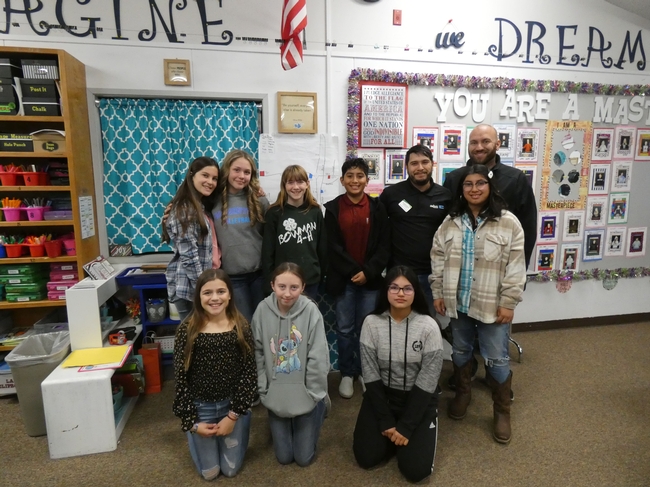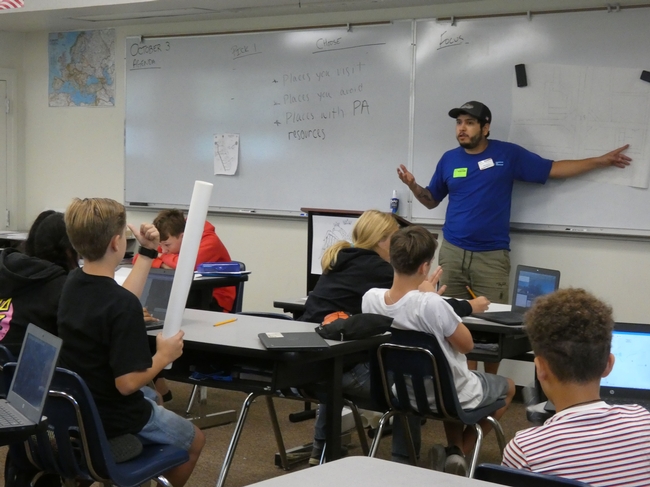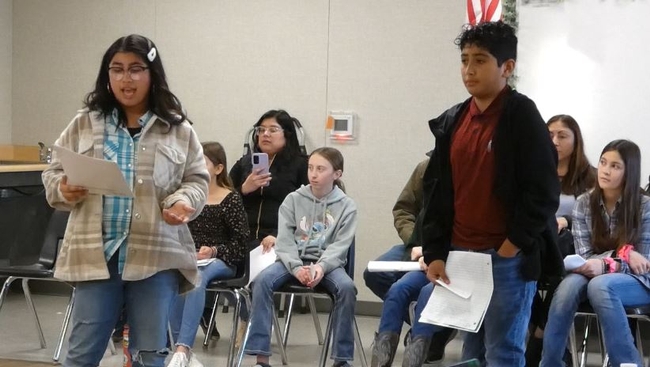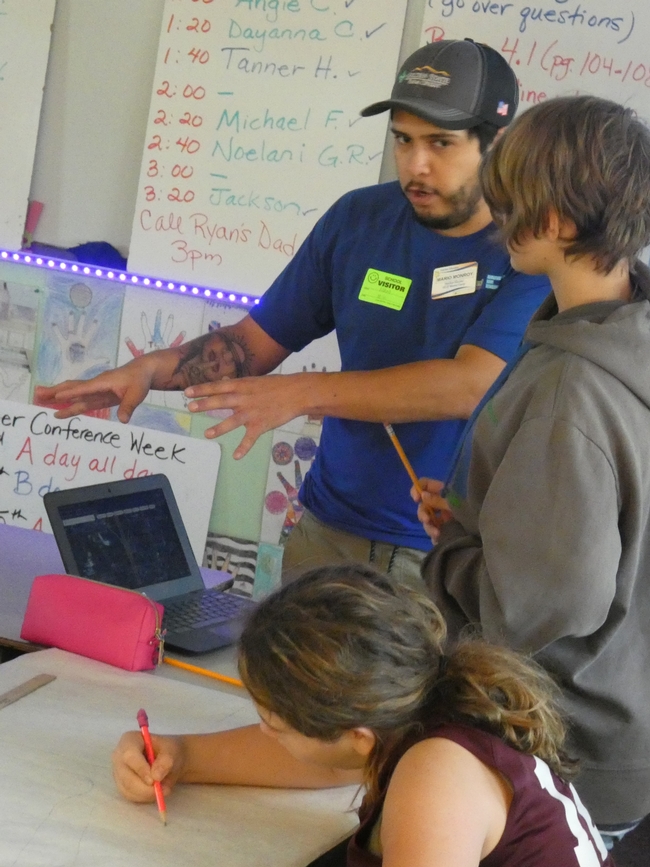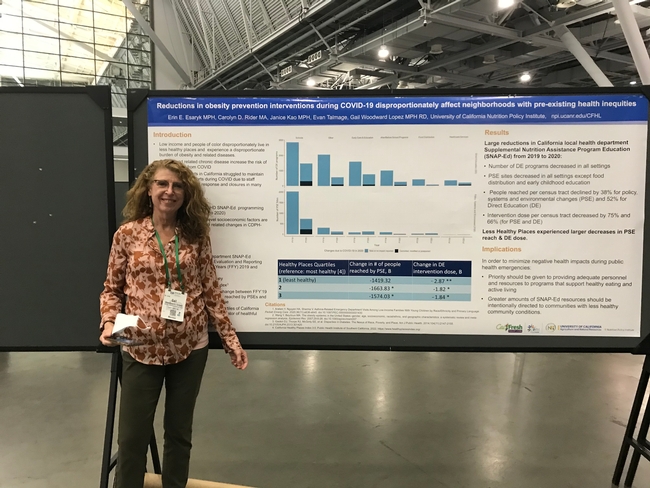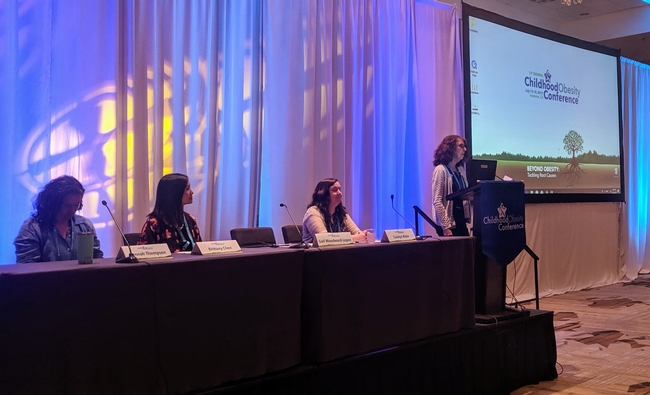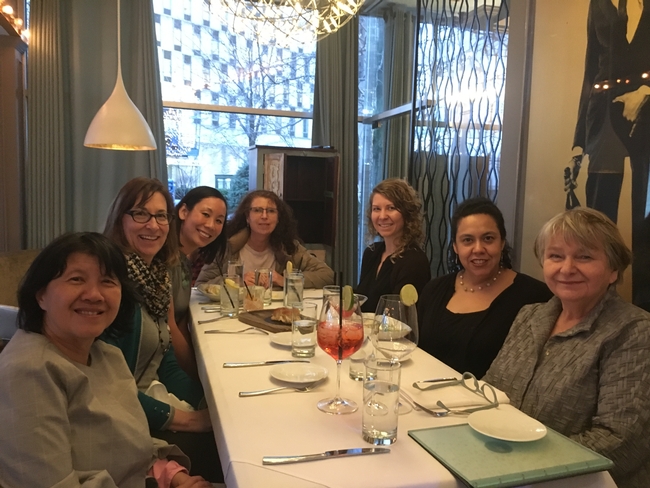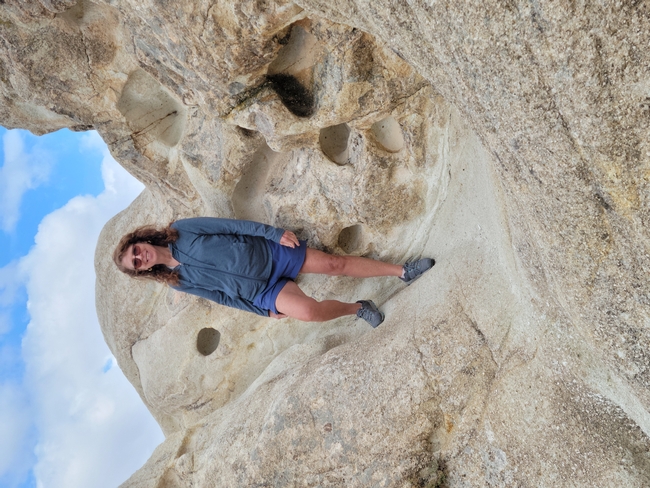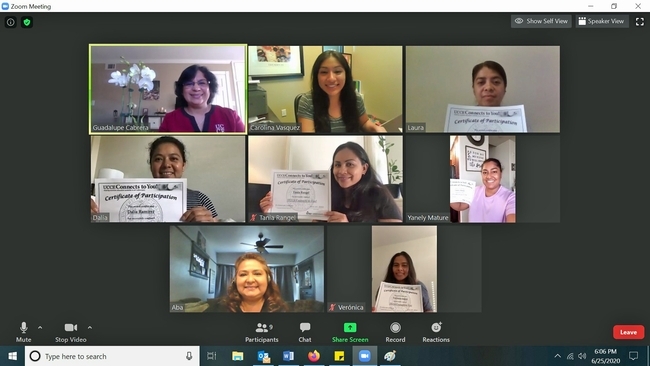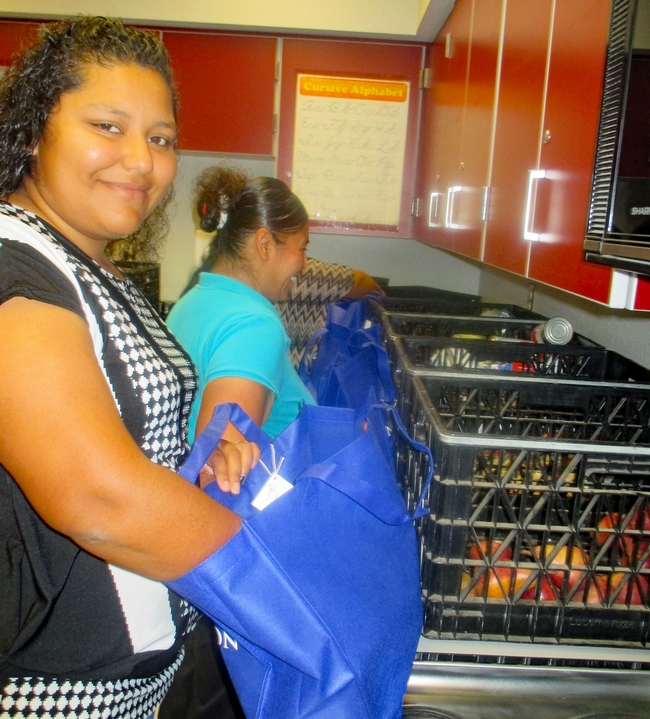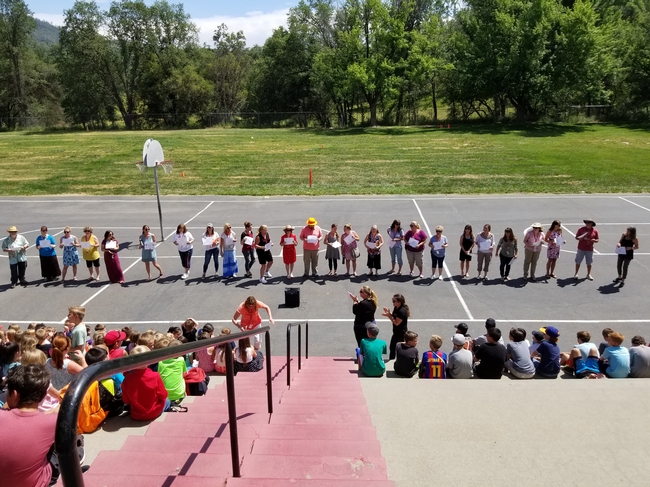Posts Tagged: SNAP-Ed
Sixth graders advocate for physical activity upgrades at school
Tehama County students empowered by CalFresh Healthy Living, UCCE educator and teachers
It's not uncommon for high school or college students to speak up and seek to improve their school environment. But at Evergreen Middle School in Tehama County, more than 100 sixth graders led the way to create healthy changes at their school.
As part of their health classes during the 2022-23 school year, the students researched the availability of spaces for physical activity, developed a survey gauging their peers' health awareness and needs, analyzed the results and data, and made recommendations for improvements.
“We learned that there's not a lot of places – except for Evergreen Middle School and some other parks around [our community of] Cottonwood – that have many physical activity places that you can easily get to or have access to,” said Bailey, one of the students.
They were guided by Mario Monroy-Olivas, a nutrition educator with CalFresh Healthy Living, University of California Cooperative Extension in Tehama, Shasta and Trinity counties. Locally administered by UC Agriculture and Natural Resources, CFHL, UCCE is one of the agencies in California that teaches nutrition to people eligible for SNAP (Supplemental Nutrition Assistance Program) – referred to as CalFresh Food in California.
Working alongside Evergreen teachers Roxanne Akers and Albert Estrada, Monroy-Olivas challenged the sixth graders to tackle a “Youth Participatory Action Research” project – a yearlong, multi-step undertaking typically designed for older teens.
“The fact that we're doing it with these younger kids, starting a lot sooner, I think it's super impactful for them to know that, together, collectively they can make huge changes that will create positive outcomes – not just for themselves but for an entire community,” Monroy-Olivas said.
Middle school students speak up at school board meeting
In February 2023, eight class representatives presented their findings to the Evergreen Union School District Board of Education. Speaking before the five-member board for 20 minutes, the young people were naturally a bit nervous.
“It was a little nerve-wracking at first, but it wasn't that bad, once we got up there and got it over with,” said Lilah, one of the presenters. “Me and a couple of my friends were doing pep talks and practicing what we were going to say.”
The students showed a composite map that they drew from their classes' investigation of spaces for physical activity in the area, and shared a brochure that outlined their research and survey results. In a survey of more than 80 of their peers, 92% of respondents said they needed more access to physical activity equipment during class breaks, recess and lunch.
“The board members were super impressed with the students, coming to the school board and doing this,” Monroy-Olivas said. “They said they haven't had students doing this kind of advocacy work; for them, it was a really big deal.”
In the end, the young people made a strong case for more water-bottle refilling stations, badminton equipment and balls for other sports, and stencils for schoolyard activities like hopscotch, four square and snail (a type of hopscotch game).
“We got almost everything we asked for, and the project we're working on now is to help put in the things we asked for,” said Lilah, adding that, during this current school year, the students (now in seventh grade) are working on acquiring the stencils and paint.
More than just equipment, students gain skills and confidence
While the promise of new gear is exciting for the youth, they are acquiring something even more valuable and enduring – a sense that they are empowered to make a difference in their community, according to Janessa Hartmann, UC Cooperative Extension community nutrition and health advisor for Tehama, Shasta and Trinity counties.
“Yes, it's important to want to do stencils and hydration stations and have more equipment,” Hartmann said, “but the bigger impact for the students is that they think: ‘Now I know that my health is important, now I know how to advocate for myself, and now I know that I can do that.'”
Monroy-Olivas said he observed tremendous growth in all the students, and especially in the self-confidence of the class representatives.
“I grew as a leader because I used to be really shy and hated talking in front of people, but through this project we're doing, this has really helped me be able to talk in front of crowds – and listen to others,” Lilah explained.
In a survey at the end of the sixth-grade project, the percentage of youth who answered “Yes, most definitely” to the statement “I want to make a difference in making my school/community healthier” jumped from 19% before the project to 44% after. And that percentage of “Yes, most definitely” replies jumped from 6% to 31% for the statement “I can use research results to come up with solutions or recommendations for making my school/community a healthier place.”
“We learned to promote what we want and try to get it as much as we can, so we can get more physical activities and more people can be included,” said Brian, another student working on the project.
“It's important so when we get older, we know how to voice our opinions and let people know what we're thinking,” added classmate Brooklynn.
Wishing that he had such an opportunity when he was growing up, Monroy-Olivas said he feels the students now know the power of their voice.
“I wholeheartedly believe that's the biggest win out of this whole project, that they're learning how to advocate for their own voice and change,” he said.
Woodward-Lopez retires after 23 years of leadership in advancing nutrition
Nutrition Policy Institute researcher influenced obesity research, SNAP-Ed evaluation
Young people across California and the U.S. enjoy healthier, more nutritious food options at school, thanks to the contributions of Gail Woodward-Lopez, who retired on July 1 as the associate director of research at the Nutrition Policy Institute, a part of University of California Agriculture and Natural Resources.
Woodward-Lopez officially joined UC ANR in 2015, when she and other researchers at the Atkins Center for Weight and Health at UC Berkeley merged with NPI. But her association with UC ANR goes back much further, as her work at CWH was always directed by UC Cooperative Extension academics – including the research that paved the way for California's “junk food ban” in schools.
Two bills, signed in 2005, set nutrition standards in California for “competitive foods”– the items sold in vending machines and from food service a la carte (as opposed to federally subsidized school meals). That legislation – which inspired similar policy changes across the country – was informed by the work of Woodward-Lopez and her colleagues, who had looked at the financial impact of establishing those standards.
“Our study was so pivotal that I literally had people calling me from the floor of the Senate or the Assembly when they were debating that legislation,” recalled Woodward-Lopez.
Changing perceptions of population weight gain
Originally intending to pursue a career in neurobiology, Woodward-Lopez found that lab work didn't suit her temperament. Seeking to work more directly on social issues, she embarked on a public health path, with an emphasis on nutritional aspects that incorporated her interest in biological sciences.
Woodward-Lopez's early work focused on a challenge that was just beginning to catch the attention of researchers: the rapid rise in the Body Mass Index (BMI) among the U.S. population. In tracing the causes of this epidemic, she and her colleagues shifted academic and public attention toward the host of environmental factors that contribute to weight gain – instead of focusing exclusively on an individual's choice to eat healthy and be physically active.
“Two decades ago, Gail led groundbreaking work to identify the determinants of obesity when child obesity was emerging as a public health concern,” said Nutrition Policy Institute Director Lorrene Ritchie. “While we and other researchers across the nation were working on generating more evidence to inform action, she had the vision that we could use a variety of existing data – from trends to trials – to point to the main causes.”
Many of the researchers' conclusions, which were published in the 2006 book “Obesity: Dietary and Developmental Influences,” stand to this day.
Helping to set the identity and agenda of the Center for Weight and Health when it was founded in 2000, Woodward-Lopez moved policy and practice beyond educational approaches and public awareness campaigns. As she noted: “No one thinks sugar-sweetened beverages are good for you.”
“Education alone is not going to work if people do not have access to the healthy foods and opportunities for physical activity, if they're not safe in their neighborhoods, or if they can't afford the healthy options,” she explained.
Given her seminal role in the field, Kaiser Permanente sought out Woodward-Lopez as a “thought partner” on the organization's community-based obesity prevention programs and school health work.
“Gail brought deep rigor and expertise, of course, but also a super-practical, community-focused perspective to our work,” said Loel Solomon, professor of health systems science at the Kaiser Permanente Bernard J. Tyson School of Medicine. “Her integrity and values around health equity were evident in everything we did together, and our communities are so much the better for it.”
Elevating and enhancing CalFresh Healthy Living
At the Nutrition Policy Institute, the focus of Woodward-Lopez's work has been refining the evaluation and delivery of SNAP-Ed, the educational component of the Supplemental Nutrition Assistance Program (commonly referred to as “food stamps”). Known in California as CalFresh Healthy Living, SNAP-Ed represents the largest single source of ongoing funding for nutrition and physical activity promotion in the state – outside of the WIC program which serves women, infants and young children.
“CalFresh Healthy Living can really impact millions of people,” Woodward-Lopez said. “For county health departments, this is one of their main sources of funding and provides the backbone for everything else they do in nutrition and physical activity.”
But given the variety of interventions implemented by health departments in response to local needs, determining the efficacy of those efforts is a daunting task. Woodward-Lopez and her NPI colleagues have been instrumental in devising creative approaches that help pinpoint the most effective public health measures.
For example, NPI researchers found that combining school policy changes with increased opportunities for physical activity during the school day was the best strategy to encourage student fitness. They discovered that reductions in nutrition programs during the COVID-19 pandemic disproportionately affected communities of color. And they also continue to emphasize that interventions need to be tailored to the specific cultural and political conditions within a community.
“I think in all of the work we do, we try to come up with those practical applications – what does this mean for communities? How can we do this differently? How are our findings actionable?” Woodward-Lopez said.
Her contributions toward the evaluation of California Department of Public Health SNAP-Ed have impressed and inspired Lauren Whetstone, chief of CDPH's Research, Evaluation and Strategic Alignment Section, Nutrition Education and Obesity Prevention Branch.
“Gail and her team have elevated the quality of our evaluation work and the evaluation support that we provide to local health department grantees,” said Whetstone, who has worked with Woodward-Lopez for nearly a decade. “Gail contributed substantially to statewide SNAP-Ed evaluation as well, again working collaboratively to ensure high quality evaluation. Our work is all the stronger due to Gail's dedication to excellent SNAP-Ed evaluation.”
To the benefit of the field and community health, Woodward-Lopez said she plans to remain engaged in her life's work.
“I'd really like to get more involved in policy through advocacy and through doing things like writing letters to the editor or social media commentary,” she said. “I already have some ideas for some editorials I want to write.”
And while she looks forward to spending more time with loved ones, traveling, and pursuing her interests in art and music, Woodward-Lopez will remain a guiding voice for advancing public health.
“Gail's leadership in public health nutrition – even after she retires – is a testament to her dedication,” Ritchie said. “She not only has contributed to sustainable changes in California and nationally, she has been a mentor to me and so many others in the field who will strive to continue her legacy.”
People interested in supporting Woodward-Lopez's legacy and the ongoing work in health and nutrition can donate to NPI's Student Fellowship, which provides students from underrepresented groups the opportunity to work on NPI research and be mentored by NPI researchers.
Federal nutrition programs respond to COVID-19
In the spring of 2020, UC Agriculture and Natural Resources' Expanded Food and Nutrition Education Program (EFNEP) and the CalFresh Healthy Living, UC (CFHL UC) Program faced the unprecedented experience of shelter-in-place and school closures due to COVID-19. Both federal nutrition education programs relied on in-person contact by UC Cooperative Extension nutrition education staff as a means of building and sustaining relationships with community members, stakeholders and partners serving vulnerable populations.
CFHL UC and EFNEP state office staff, in collaboration with the Center for Nutrition in Schools, reacted quickly to serve their clientele's needs. The coordinated effort of state office teams resulted in the dissemination of a staff needs assessment, which culminated in the training of over 150 educators and supervisors to quickly pivot lessons for online and distance learning. State staff and educators began designing online curricula delivery models to re-engage students, creating a library of virtual lessons with distance-learning strategies. This included using Zoom, social media platforms such as Facebook Live and YouTube, and learning platforms such as Google Classroom. To provide quality assurance, reach and outcome measures also began undergoing adaptation for this new learning environment.
Examples of new remote learning capabilities include:
-
More than 60 online lessons under development for children pre-kindergarten through 8th grade that emphasize healthy eating, active living and gardening.
-
CalFresh Healthy Living, UCCE county programs are developing the online delivery of five adult curricula, including UC-developed Plan, Shop, Save and Cook and Making Every Dollar Count that provide food resource management tips, as well as ideas for how to stay active and purchase healthy food on a limited budget. These lessons are particularly valuable at this time of high unemployment.
-
EFNEP's Technology and Social Media Plan includes a pilot of ‘blended learning' using mail, phone and video chat for our UCCE Connects to You Series. CFHL UC also utilizes mailings and phone call follow-ups with this curriculum.
Further, CFHL UC educators are offering lessons and short educational segments online, maintaining school gardens, working at food banks (with the permission of local county directors) and, in partnership with school meal programs, offering complimentary nutrition education and physical activity take-home lessons and resources to students and families at meal pick up locations. Youth engagement projects continue to engage student leaders online through Youth-Led Participatory Action Research (YPAR) projects.
In response to COVID-19, the EFNEP and CFHL UC state and county staff continue to build and enhance the skills of our educators while serving California's most vulnerable communities. These efforts are critical to maintain trusted relationships, which both programs successfully established over decades of service to promote healthy people and communities in California.
SNAP-Ed: It's a life changer
In January, more than 600 Supplemental Nutrition Assistance Program – Education (SNAP-Ed) professionals across California gathered in Sacramento for the SNAP-Ed Local Implementing Agency Forum. This two-day annual gathering celebrates SNAP-Ed work, offers a platform to share lessons learned, and provides training opportunities. The 2018 theme was: “Building Power through Stories of Change”.
During one of the plenary sessions, Stories of Change: Voices from the Community, we heard directly from participants about their struggles to achieve good health in difficult situations – where time and money are limited. Listening to SNAP-Ed participants' stories of life changing experiences in health and fitness was captivating. However, one thing was clear – it all began with first steps: deciding to change, walking into a SNAP-Ed class, bonding with a compelling educator. These often invisible steps are needed to make enduring change. The stories solidified the importance and impact of SNAP-Ed in the community.
The SNAP-Ed LIA Forum also showcased county work through a poster session. During this time, we heard UC CalFresh Nutrition Education Program educators and administrators discuss their work along with their SNAP-Ed colleagues. The level of commitment and collaboration that is occurring every day across the state was compelling.
Here are just a couple UC CalFresh stories:
Creating CHEFs
In Stanislaus County, 40 percent of low-income families are food insecure. The United Way, UC CalFresh Nutrition Education, Second Harvest Food Bank, and Caswell and Bret Hart elementary schools worked together to find ways to increase elementary school students and their families' access to and consumption of healthy food and beverages.
They created the CHEF program; CHEF stands for Cooking, Healthy Eating & Food. Participant's help prepare meals during nutrition education classes. They take home ingredients to make the recipe for their families at the end of each 4- to 6-week series. The classes teach families about MyPlate and how to make long-term, healthier choices by reading labels, exercising portion control, and shopping on a budget.
CHEF also provides more than 340 children in the two afterschool programs with 18-pound bags of food twice per month. From 2016 to date, 197 adults participated in nutrition education classes. More than 200,000 pounds of healthy food were provided to Stanislaus County families.
Stepping it up
In Tuolumne County, the UC Cooperative Extension Central Sierra region helped start the "Tuolumne County: Step It Up" campaign across the school district. Thirty percent of the population in Tuolumne County is overweight or obese. The UCCE staff considered how to assist in reducing this statistic and provide a model for a simple way to achieve a healthier lifestyle.
Physical activity is an important aspect of health in children. Benefits include:
- Improved heart health
- Increased muscle strength and bone health
- Improved weight control
- Decreased risk for many chronic diseases
- Positive effect on mental health
- Inclination to continue healthy lifestyle into adulthood
- Improved educational outcomes
UC CalFresh, Tuolumne County Schools, County Public Health, and the Local ATCAA Food Bank invited school staff to form teams at their schools for a six-week competition, logging their steps along the way. The competition ran from April 6, 2017, to National Walking Day, May 17, 2017. The data were captured through online spreadsheets and emailed weekly by a designated team captain.
The ‘Step It Up' competition garnered significant community support. Local businesses donated prizes for winning staff, which were presented at school-wide assemblies with certificates for each participant. Students contributed to their step count through recess walks, “walk-and-talk” roving lectures, or school-wide walking mornings.
With five teams and over 180 participants, the steppers collectively walked 25,081 miles. The winning school was acknowledged by their district school board and have enacted a policy dedicating time every Wednesday morning to walk as a school.
SNAP-Ed: It's a life changer!
As members of the community, UCCE educators and staff lead the way to build resources that establish healthy lifestyles where they live and serve. Ultimately, their daily work is building the capacity for local institutions and leaders to make a long lasting difference. Hats off to all of you, your partners and community members – your efforts make SNAP-Ed a life changer!
Author: Andra Nicoli, UC CalFresh State Office, with county contributions from Jaci Westbrook, Gretchen Birtwhistle and Wylie Skillman
Tackling childhood obesity: A systems change approach
On paper, the charge was clear: launch a statewide effort to integrate the nutrition education programs of USDA SNAP-Ed funded partners. Address childhood obesity and food insecurity holistically, yet specifically. Do this through policy, systems and environmental approaches that will leverage community participation and resources in order to create sustainability at the local level, and do it as funding is declining in SNAP-Ed programs.
But what would this integrated effort actually look like in practice? How could a single effort weave together the many agencies, actors, and systems that influence a child's earliest years, a family's food selection, and school and community activities? How could the people around a table, some meeting for the first time, coalesce around a shared vision, let alone mutually agreed strategies?
A problem as multifaceted as childhood obesity requires a similarly complex public health approach to meet the challenge. It is with this charge that over the past four years UC CalFresh has been working across California on nutrition education and obesity prevention with the California Department of Social Services, the California Department of Public Health, the California Department of Aging, and Catholic Charities to redefine Supplemental Nutrition Assistance Program-Education (SNAP-Ed, which is funded by the USDA Food and Nutrition Service).
The SNAP-Ed mission in California is to inspire and empower underserved Californians to improve their health and the health of their communities by promoting awareness, education, and community change through diverse partnerships, resulting in healthy eating and active living.
SNAP-Ed work is executed through county-led integrated workplans which now embody policy, systems and environmental (PSE) change in the body of work previously seen as a direct education program in schools and communities. Adding PSE activities to SNAP-Ed work acknowledges that a systems change approach that comprehensively addresses nutritional health where people live, learn, work, shop and play most effectively assures that children and their families will benefit from SNAP-Ed educational efforts.
Technical assistance through education on food and food resource management coupled with assisting community members in making changes to their environment is a viable method of creating sustainable change. These types of comprehensive changes in schools and communities have been cited by a recent Robert Wood Johnson report to help children grow up at a healthy weight.
- Tackling obstacles such as access to affordable fresh fruit and vegetables, safe areas to recreate, safe routes to school, and programs/curricula that encourage physical activity are important aspects of initiating long lasting community health and lifestyle changes.
- Teaming with the Department of Transportation or environmental programs such as Resilient Schools can fuse nutritional work with those working in other areas that contribute to and foster a safe, healthy community.
- Wellness policies in schools that encourage good nutrition and physical activity institutionalize healthy lifestyle choices.
- Programs like the Smarter Lunchroom Movement help schools and students make the healthy choice in food and beverages the easy choice.
- Environmental supports such as murals in the lunchroom or on school/community grounds visually reinforce key messages. On the playground, stencils depicting fruits and vegetables with key messages help motivate student's movement and play while reinforcing lessons learned in the classroom.
- Garden-based learning facilitates student and community members' exploration of low-cost methods to add fresh fruits and vegetables to their daily meal plan. Research shows that nutrition and gardening experiences, linked to academic standards for a specific age group, can increase vegetable and fruit consumption and physical activity.
Now, let's explore how these changes in the type of work executed through SNAP-Ed is poising California communities to tackle childhood obesity.
There is general agreement through research that the first years of children's lives can determine the rest of their development. Across ideological divides, there is consensus that investing early makes sense — it helps children develop healthy habits that can last a lifetime — creating a high return on the investment of public dollars.
As described, SNAP-Ed funded and non-funded partners in communities are tackling childhood obesity and food insecurity on multiple fronts. It has been initiated with five broad-based levers for change:
- Offering evidence-based direct nutrition education curricula and technical assistance
- Developing state and local partnerships
- Using data to inform strategies
- Building commitment among stakeholders
- Tackling policy and practice change
However, in the end, support in counties from SNAP-Ed funded partners requires community leadership and long term ownership to succeed. Each community is armed with essential knowledge about local context to make sense of these levers and to pursue emergent opportunities.
At the state and local level, the development and implementation of integrated workplans with community members input is a blueprint charting each counties course.
At the state level, the past four years of developing SNAP-Ed integrated workplans created several lessons in systems change evolution:
Listen and learn
The more we listen and support community members, bringing their ideas to the forefront of our work, the more sustainable our efforts will be.
Connect the dots and engage
Fragmentation and silos create a diverse but disconnected sector. Communicate and connect as much as possible.
Create mission and values statements that unify - then operate transparently
As you get to know the community members and organizations that you are working with— together create your mission and values statement and make that your solidifying “call to arms” — then work transparently to fulfill your mutual objectives.
Embrace tensions
Different settings, standards, and social norms create tension — successful systems change efforts face, rather than circumvent, these tensions…be respectful and “lean in”.
Foster a long term approach/celebrate short term “wins”
As we review the many factors that lead to childhood obesity and food insecurity, use long term systems change strategies, foster sustained commitment, and celebrate successes, no matter how small.
Be adaptable but purposeful
Reflect on how different organizations work and understand that your perspective may be a result of your vantage point. Try to be in another organization's or person's shoes, recognize their impediments, then work together with this in mind. Good strategies are shaped by reflection and steered with an understanding that there may be a need for course correction.
Keep a unified resolve
A recent Robert Wood Johnson Foundation report concluded that between 2005 and 2010 California saw “a modest but significant decline” in childhood obesity of 1.1 percent in grades 5, 7 and 9. In addition, a 2013 Centers for Disease Control and Prevention report indicated progress in the health of California preschoolers enrolled in federal health and nutrition programs. The report cited that “obesity rates among 2-4 yr olds from low income families dropped 2.9 percent from 17.7 percent in 2008 to 16.8 percent in 2011.” This data speaks to the significance of a comprehensive approach in preventing childhood obesity. Further, it emphasizes the importance of the teamwork provided by a network of state and local agencies, acting with community members, to make a difference in the lives of children.
California data reported by the 2016 Robert Wood Johnson Foundation:
- Since 2004, schools have removed soda and other sugar sweetened beverages from premises.
- Since 2007, schools have limited the calories, fat saturated, fat and sugar in snacks sold on their premises.
- Since 2012, school districts have been required to make free, fresh drinking water available in school food service areas.
- Since 2006, $40 million has been committed in annual dedicated state funding for elementary school physical education.

